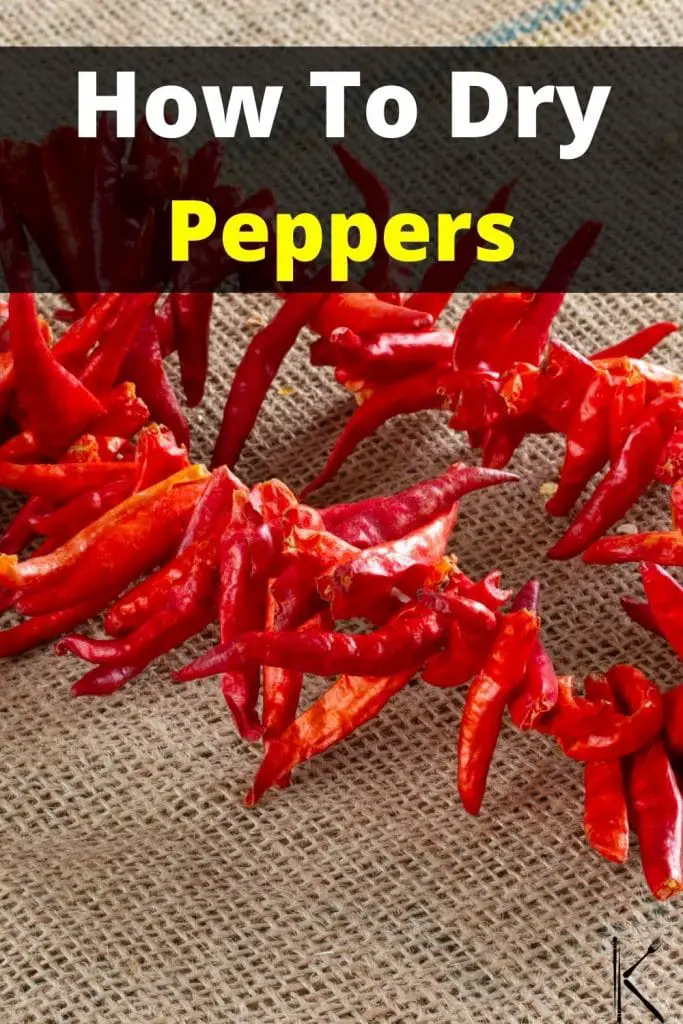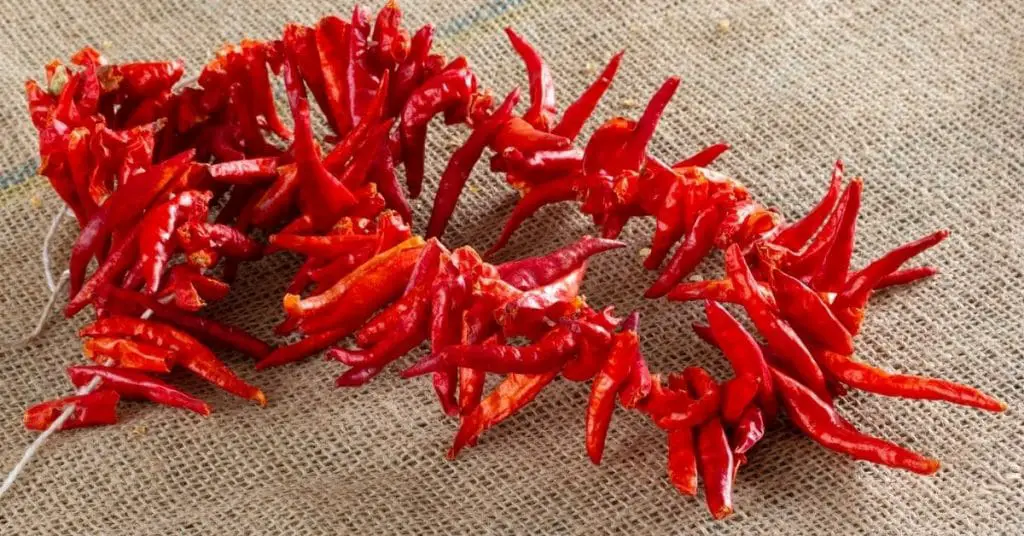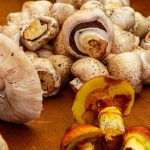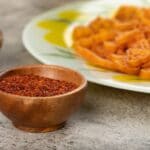In summary: There are two methods to dry peppers: air dry by hanging and oven drying. Both methods require cleaning and cutting the peppers before dehydrating them.
Peppers can be used fresh or dried and add a big punch of flavor to dishes. Dehydrating peppers is a way to preserve them by removing the moisture, concentrating the flavor, and extending their shelf-life significantly.
Almost any type of hot pepper or chili can be dried. Follow the guide below to find out how to dry your own peppers at home.
Can Peppers Be Dried?
Yes, drying peppers significantly extends their shelf life. They can be air-dried, dried in the oven, or by using a food dehydrator. Air-drying them by hanging is best used for chilies with thin flesh and only if you live in a dry climate with warm daytime temperatures (above 85˚F/20˚C). High humidity can cause the peppers to mold before they dry sufficiently.
Due to their naturally high moisture content, it is important to ensure that the peppers are fully dehydrated before packing them. Any residual moisture will cause them to mold during storage.
The better the quality of the peppers before drying, the better they will be once dehydrated. If they are damaged or have started going bad, don’t use them for drying.
How to Dry Peppers
You can apply these methods below to dry all types of chili peppers, including serrano peppers.
We recommend wearing gloves when handling hot peppers.
Method 1: Air Dry by Hanging
(best for smaller, thin varieties)
Step 1: Clean
Wash the fresh peppers to remove dirt and dry them well with a kitchen towel to remove moisture.
Step 2. Thread the peppers
Thread the chilies through their stems using a long needle and thin string. Leave enough space between the peppers for good airflow.
Step 3: Hang
Hang the string of threaded chilies to dry in a light, well-ventilated room. Do not choose an area that is humid or moist such as near a stove or kettle. They should be dry within 3 to 4 weeks.
Step 4: Store
Once the peppers are shriveled, brittle, and break easily when bent, they are fully dry. If they are still pliable, they need more hanging time.
Carefully remove them from the string and pack them into an airtight container or resealable storage bag. Store them out of direct sunlight in a dry, cool area. Label the container with the date.
Tip: Pulse the dried chilies in a food processor to make red pepper flakes or grind them into a powder to make your own chili seasoning.
Method 2: Oven Drying
Here’s how to dehydrate peppers in oven without a dehydrator:
Step 1: Clean and Cut
Wash the peppers to remove dirt and dry them with a kitchen towel to remove any moisture.
Small peppers can be left whole, however, it is best to cut large ones into even-sized pieces for quicker drying. Use gloves and do not touch your face while handling spicy peppers.
Step 2: Prepare
Preheat the oven to 150˚F (65°C). Spread the peppers out on a baking sheet lined with parchment paper. Arrange the peppers in a single layer so that they do not overlap.
Step 3: Bake
Place the baking sheet with peppers in the oven. Keep the oven door propped open slightly to allow moisture to escape. Rotate the baking sheet every 30 minutes, checking on the peppers. They will take 1 to 2 hours to dehydrate, depending on the variety.
Step 4: Store
Once the peppers are shriveled, brittle, and crumble easily, they are fully dry. If they are still pliable, they need more time in the oven. Remove the dry peppers from the oven and let them cool down for 20 to 30 minutes. They need to be completely cooled before packing to avoid condensation and moisture build-up.
Pack them into glass jars or resealable storage bags. Store them out of direct sunlight in a dry, cool area.
Tip: Follow the same method when using a dehydrator, however, set the temperature of the dehydrator between 125˚F and 135˚F (60°C) as per the manufacturer’s manual.
Types of Chili Peppers that Dry Well
Peppers are used worldwide and are very versatile in all types of dishes from salads and soups, to curries, marinades, sauces, and stews. They can even be incorporated into desserts and pair especially well with chocolate and certain types of fruits. Dried hot peppers can be rehydrated whole, ground into powder, or cut into small flakes.
The following 6 types of peppers dry well and are commonly used in cooking in their dried form.
Poblano Chilies
Once dried, poblano peppers are referred to as Ancho chilies. These are some of the most popular chiles used in Mexican cooking. They are deep red with a smoky and mildly spicy heat. They are either ground into a powder with a spice grinder or rehydrated into red chili sauces.
Cayenne Pepper
Cayenne peppers are commonly purchased as crushed flakes in stores. They are also ground into a powder form and widely used in meat or vegetable seasonings, sauces, stews, and soup.
Jalapeño Chilies
Jalapeños can be either green or red and are known for their spicy flavor. Once smoked and dried, they are known as chipotle peppers, however, they can also be dried without smoking.
Paprika
Paprika is a hot and somewhat sweet pepper. It also comes in a dried, smoked version infused with natural wood smoke flavor before being ground into powder. Smoked paprika is ideal for seasoning dry-rub grilling meats.
Chile de Arbol
These are very spicy peppers with a nutty and earthy tone. They add a great kick to meals and should be used carefully for those not used to spicy cuisine. They are also often used in pickling brines.
Sweet Peppers
Sweet peppers, also known as bell peppers, come in green, red, orange, and yellow varieties of different shapes and sizes. Each color has a different flavor and level of sweetness. Drying these peppers in small diced pieces makes it easy to add directly to soups and stews. Dried bell peppers are best used rehydrated in cooked dishes to add flavor, but don’t necessarily add the same heat as spicy chilies.
FAQ
Conclusion
When it comes to chili peppers a little goes a long way. Dry your own peppers at home to create the perfect heat-blend to suit your palate and avoid the added preservatives from store-bought spices.
Make sure the peppers are fully dehydrated and cooled before packing. Store them in a cool, dry place and check them occasionally for mold, especially if stored whole. A little effort to dry out your peppers not only prevents waste and saves money, but will ensure you have a big burst of flavor in the pantry all year long.
Also check our guides on how to dry chives, mint and sage.

*image by reflex_safak/depositphotos









